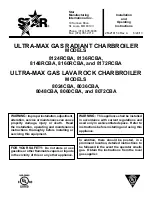
25
Hoval STU Wood Pellet Boiler
Filling the system
Recommendation
It is recommended that each system should
be filled or refilled with treated water and specialist firms
will be able to advise
in this respect.
Water treatment
There is basic need to treat water contained in all heating and indirect
hot water systems, particularly open vented systems.
One millimetre of lime reduces the heat conversion from flame via
metal to water by 10%.
In practice the deposition of these salts is liable to cause noises from
the boiler body or even premature boiler failure. Corrosion and the
formation of black iron oxide sludge will ultimately result in premature
radiator failure.
Open vented systems are not completely sealed off from the
atmosphere as it is essential to provide a tank open to atmosphere
if proper venting and expansion of system water is to be achieved.
The same tank is used to fill the water and it is through the cold feed
pipe that system water expands into the tank when the boiler passes
heat into the system.
Conversely when the system cools, water previously expanded is
drawn back from the tank into the system together with a quantity
of dissolved oxygen.
Even if leakage from the heating and hot water systems is eliminated
there will be evaporation losses from the surface of the tank
which, depending on ambient temperature, may be high enough to
evaporate a large portion of the system water capacity over a full
heating session.
There will always be corrosion within a heating hot water system
to a greater or lesser degree irrespective of water characteristics
unless the initial fill water from the mains is treated. Even the water
in closed systems will promote corrosion unless treated.
For these reasons Hoval strongly recommend that when necessary
the system be thoroughly cleaned, prior to the use of a stable inhibitor,
which does not require continual topping up to combat the effects of
hardness salts and corrosion.
Hoval advise contact directly with major specialists on water
treatment such as Goodwater or Houseman.
Check the following:
• All connections are made and tightened.
• Instrument pockets are fitted and water tight.
• Spare sockets are fitted with plugs and are
water tight.
• All valves in the heating circuit are open.
• Mixing or diverting valves are opened half way,
then gradually fill with water until the altitude
gauge (if fitted) indicates the correct head and
the header tank is filled to appropriate level.
• The installation is completely vented.
• If a pressurisation unit is installed reference
should be made to the makers filling
instructions and applied.
• Installation debris and any deposits from the
system are not allowed into the boiler.
• The boiler is flushed out through the drain
connection to ensure that the boiler is clean
inside.
• A large strainer is fitted to older systems to
remove deposits before the return enters the
boiler.
Important
The whole system must be thoroughly
flushed with water to wash out
foreign matter and impurities in accordance
with CIBSE/BSRIA guidelines.
Water Flow and Return Temperatures
1.
The flow temperature can be adjusted to a 85
o
C maximum.
2.
The return temperature should be controlled to be not less than 60
o
C at all times by the use of suitable bypass/diverting
controls. Always ensure that the return pipework to the boiler is connected to both return connections equally.
3.
Differentials between the flow and return should not exceed 25K. Where a differential is to exceed 25K advise Hoval as
considerations are necessary and alternative solutions may be appropriate.
















































